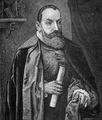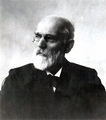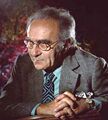Template:Selected anniversaries/August 22: Difference between revisions
No edit summary |
No edit summary |
||
| Line 1: | Line 1: | ||
<gallery> | <gallery> | ||
||1647 | ||1647: Denis Papin born ... physicist and mathematician, developed pressure cooking. | ||
||Maria Cunitz | ||1664: Maria Cunitz dies ... astronomer, and one of the most notable female astronomers of the modern era. She authored a book ''Urania propitia'', in which she provided new tables, new ephemera, and a more elegant solution to Kepler's problem. Pic. | ||
||1752 | ||1752: William Whiston dies ... mathematician, historian, and theologian. | ||
||1771 | ||1771: Henry Maudslay born ... engineer. | ||
||1796: Baden Powell born ... mathematician and Church of England priest. He held the Savilian Chair of Geometry at the University of Oxford from 1827 to 1860. Powell was a prominent liberal theologian who put forward advanced ideas about evolution. Pic. | ||1796: Baden Powell born ... mathematician and Church of England priest. He held the Savilian Chair of Geometry at the University of Oxford from 1827 to 1860. Powell was a prominent liberal theologian who put forward advanced ideas about evolution. Pic. | ||
||1828 | ||1828: Franz Joseph Gall dies ... neuroanatomist and physiologist. | ||
||1834 | ||1834: Samuel Pierpont Langley born ... physicist and astronomer. | ||
||Leopoldo Nobili | ||1835: Leopoldo Nobili dies ... physicist who invented a number of instruments critical to investigating thermodynamics and electrochemistry. Pic. | ||
||1849 | ||1849: The first air raid in history. Austria launches pilotless balloons against the city of Venice. | ||
File:Jan Kochanowski.png|link=Jan Kochanowski (nonfiction)|1854: [[Jan Kochanowski (nonfiction)|Poet Jan Kochanowski]] dies. He established poetic patterns which would become integral to the Polish literary language. | File:Jan Kochanowski.png|link=Jan Kochanowski (nonfiction)|1854: [[Jan Kochanowski (nonfiction)|Poet Jan Kochanowski]] dies. He established poetic patterns which would become integral to the Polish literary language. | ||
||1860 | ||1860: Paul Gottlieb Nipkow born ... technician and inventor, created the Nipkow disk. | ||
||1860 | ||1860: Alfred Ploetz born ... physician, biologist, and eugenicist. | ||
||1866: George Shillibeer dies ... pioneer of omnibuses. Having founded a coach-building enterprise in Paris (1825), he expanded to include buses. On 4 Jul 1829, he commenced the first regular bus service from London to Paddington, carrying up to 20 passengers and in a coach drawn by three horses. Shillibeer adopted the word omnibus. He boasted it offered a safer and more comfortable ride than ordinary stagecoaches, since all passengers would ride inside. He was followed by imitators then more competition from the discovery that a trolley running on tracks could pull twice the payload. Although Shillibeer had revolutionized London's transport, he went bankrupt and spent time in debtors' prison. He eventually converted his omnibuses into "Shillibeer's Funeral Coaches". Pic. | ||1866: George Shillibeer dies ... pioneer of omnibuses. Having founded a coach-building enterprise in Paris (1825), he expanded to include buses. On 4 Jul 1829, he commenced the first regular bus service from London to Paddington, carrying up to 20 passengers and in a coach drawn by three horses. Shillibeer adopted the word omnibus. He boasted it offered a safer and more comfortable ride than ordinary stagecoaches, since all passengers would ride inside. He was followed by imitators then more competition from the discovery that a trolley running on tracks could pull twice the payload. Although Shillibeer had revolutionized London's transport, he went bankrupt and spent time in debtors' prison. He eventually converted his omnibuses into "Shillibeer's Funeral Coaches". Pic. | ||
||1873 | ||1873: Alexander Bogdanov born ... physician and philosopher. | ||
||1985: Paul Peter Ewald dies ... physicist and crystallographer whose theory of X-ray interference by crystals was the first detailed, rigorous theoretical explanation of the diffraction effects first observed in 1912 by his fellow physicist Max von Laue. Pic: https://www.todayinsci.com/8/8_22.htm | ||1985: Paul Peter Ewald dies ... physicist and crystallographer whose theory of X-ray interference by crystals was the first detailed, rigorous theoretical explanation of the diffraction effects first observed in 1912 by his fellow physicist Max von Laue. Pic: https://www.todayinsci.com/8/8_22.htm | ||
||Abraham "Abe" Sinkov | ||1907: Abraham "Abe" Sinkov born ... cryptanalyst. | ||
||1913 | ||1913: Bruno Pontecorvo born ... physicist and academic. | ||
||1915 | ||1915: James Hillier born ... scientist, co-designed the electron microscope. | ||
||1918 | ||1918: Korbinian Brodmann dies ... neurologist and academic. | ||
File:Johannes Diderik van der Waals.jpg|link=Johannes Diderik van der Waals (nonfiction)|1919: Theoretical physicist and crime-fighter [[Johannes Diderik van der Waals (nonfiction)|Johannes Diderik van der Waals]] publishes new class of [[Gnomon algorithm functions]] which detect and prevent [[crimes against mathematical constants]] based on the states of gases and liquids. | File:Johannes Diderik van der Waals.jpg|link=Johannes Diderik van der Waals (nonfiction)|1919: Theoretical physicist and crime-fighter [[Johannes Diderik van der Waals (nonfiction)|Johannes Diderik van der Waals]] publishes new class of [[Gnomon algorithm functions]] which detect and prevent [[crimes against mathematical constants]] based on the states of gases and liquids. | ||
File:Ray Bradbury 1959.jpg|link=Ray Bradbury (nonfiction)|1920: Science fiction writer and screenwriter [[Ray Bradbury (nonfiction)|Ray Bradbury]] born. ''The New York Times'' will call Bradbury "the writer most responsible for bringing modern science fiction into the literary mainstream". | File:Ray Bradbury 1959.jpg|link=Ray Bradbury (nonfiction)|1920: Science fiction writer and screenwriter [[Ray Bradbury (nonfiction)|Ray Bradbury]] born. ''The New York Times'' will call Bradbury "the writer most responsible for bringing modern science fiction into the literary mainstream". | ||
||1932: The first experimental television program broadcast from the BBC, London. | ||1932: The first experimental television program broadcast from the BBC, London. | ||
| Line 48: | Line 46: | ||
File:Janet Beta at ENIAC.jpg|link=Janet Beta at ENIAC|1943: Signed first edition of ''Janet Beta at ENIAC'' traded for freshly minted [[1943 Eleanor Roosevelt dime]]. | File:Janet Beta at ENIAC.jpg|link=Janet Beta at ENIAC|1943: Signed first edition of ''Janet Beta at ENIAC'' traded for freshly minted [[1943 Eleanor Roosevelt dime]]. | ||
||1933 | ||1933: Alexandros Kontoulis dies ... Greek general and diplomat. | ||
||1940 | ||1940: Oliver Lodge dies ... physicist and academic. | ||
||1945: Ida Henrietta Hyde dies ... physiologist known for developing a micro-electrode powerful enough to stimulate tissue chemically or electronically, yet small enough to inject or remove tissue from a cell. Pic. | ||1945: Ida Henrietta Hyde dies ... physiologist known for developing a micro-electrode powerful enough to stimulate tissue chemically or electronically, yet small enough to inject or remove tissue from a cell. Pic. | ||
||1953 | ||1953: The penal colony on Devil's Island is permanently closed. | ||
||1962 | ||1962: The OAS attempts to assassinate French president Charles de Gaulle. | ||
|| | ||1962: The ''Savannah'', the world's first nuclear-powered ship, completed her maiden voyage from Yorktown, Va., to Savannah, Ga. | ||
||1967 | ||1963: X-15 Flight 91 reaches the highest altitude of the X-15 program (107.96 km (67.08 mi) (354,200 feet)) ... the X-15 rocket plane achieved a world record altitude of 354,200 feet (107,960 m, 67 miles) with U.S. Air Force pilot Joseph A. Walker, flight 91 of the series of test flights. Its internal structure of titanium was covered with a skin of Inconel X, a chrome-nickel alloy. To save fuel, the X-15 was air launched from a B-52 aircraft at about 45,000 ft. Test flights between 8 Jun 1959 and 24 Oct 1968 provided data on hypersonic air flow, aerodynamic heating, control and stability at hypersonic speeds and piloting techniques for reentry used in the development of the Mercury, Gemini, and Apollo spaceflight programs. | ||
||1967: Gregory Goodwin Pincus, American biologist and academic, co-created the birth-control pill (b. 1903) | |||
File:Jacob Bronowski.jpg|link=Jacob Bronowski (nonfiction)|1974: Mathematician, historian of science, theatre author, poet, and inventor [[Jacob Bronowski (nonfiction)|Jacob Bronowski]] dies. | File:Jacob Bronowski.jpg|link=Jacob Bronowski (nonfiction)|1974: Mathematician, historian of science, theatre author, poet, and inventor [[Jacob Bronowski (nonfiction)|Jacob Bronowski]] dies. | ||
| Line 66: | Line 66: | ||
File:George E P Box.jpg|link=George E. P. Box (nonfiction)|1975: Statistician and educator [[George E. P. Box (nonfiction)|George E. P. Box]] publishes new class of [[Gnomon algorithm functions]], based on time-series analysis and Bayesian inference, which detect and prevent [[crimes against mathematical constants]]. | File:George E P Box.jpg|link=George E. P. Box (nonfiction)|1975: Statistician and educator [[George E. P. Box (nonfiction)|George E. P. Box]] publishes new class of [[Gnomon algorithm functions]], based on time-series analysis and Bayesian inference, which detect and prevent [[crimes against mathematical constants]]. | ||
||Andrzej Mostowski | ||1975: Andrzej Mostowski dies ... mathematician. He is perhaps best remembered for the Mostowski collapse lemma. | ||
||1977: Karl Walter Schröter dies ... mathematician and logician. Later on, after the war, he made important contributions concerning semantic consequences (German: semantische Folgerungsrelationen) and provability logic (German: syntaktische Ableitbarkeitsrelationen). He worked as a mathematical theoretician and cryptanalyst for the civilian Pers Z S, the cipher bureau of the Foreign Officeduring World War II. Pic. | |||
|| | ||1989: The first complete ring around Neptune was discovered in photographs transmitted by Voyager 2 to the Jet Propulsion Laboratory in the U.S. Dusty debris was seen to form a tenuous but complete ring about 17,000 miles above Neptune's clouds. The material in the ring appeared be distributed uniformly through the dark circle, though whether fine or large particles was undetermined. The ring lies just outside the orbit of one of the planet's small moons, designated then as 1989 N3, also newly discovered by Voyager 2. Only arcs - fragments of rings around Neptune, had previously viewed from Earth-based observations, which were also shown as arcs in photographs taken by Voyager 2 eleven days earlier. Pic: https://www.todayinsci.com/8/8_22.htm | ||
||2004 | ||2004: Versions of The Scream and Madonna, two paintings by Edvard Munch, are stolen at gunpoint from a museum in Oslo, Norway. | ||
||Timothy "Tim" Poston | ||2017: Timothy "Tim" Poston dies ... mathematician best known for his work on catastrophe theory. Pic. | ||
||Michael John Caldwell Gordon | ||2017: Michael John Caldwell Gordon dies ... British computer scientist. He led the development of the HOL theorem prover, an environment for interactive theorem proving in a higher-order logic. | ||
</gallery> | </gallery> | ||
Revision as of 20:27, 16 August 2018
1854: Poet Jan Kochanowski dies. He established poetic patterns which would become integral to the Polish literary language.
1919: Theoretical physicist and crime-fighter Johannes Diderik van der Waals publishes new class of Gnomon algorithm functions which detect and prevent crimes against mathematical constants based on the states of gases and liquids.
1920: Science fiction writer and screenwriter Ray Bradbury born. The New York Times will call Bradbury "the writer most responsible for bringing modern science fiction into the literary mainstream".
1943: Signed first edition of Janet Beta at ENIAC traded for freshly minted 1943 Eleanor Roosevelt dime.
1974: Mathematician, historian of science, theatre author, poet, and inventor Jacob Bronowski dies.
1975: Statistician and educator George E. P. Box publishes new class of Gnomon algorithm functions, based on time-series analysis and Bayesian inference, which detect and prevent crimes against mathematical constants.





